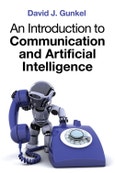Communication and artificial intelligence (AI) are closely related. It is communication - particularly interpersonal conversational interaction - that provides AI with its defining test case and experimental evidence. Likewise, recent developments in AI introduce new challenges and opportunities for communication studies. Technologies such as machine translation of human languages, spoken dialogue systems like Siri, algorithms capable of producing publishable journalistic content, and social robots are all designed to communicate with users in a human-like way.
This timely and original textbook provides educators and students with a much-needed resource, connecting the dots between the science of AI and the discipline of communication studies. Clearly outlining the topic's scope, content and future, the text introduces key issues and debates, highlighting the importance and relevance of AI to communication studies. In lively and accessible prose, David Gunkel provides a new generation with the information, knowledge, and skills necessary to working and living in a world where social interaction is no longer restricted to humans.
The first work of its kind, An Introduction to Communication and Artificial Intelligence is the go-to textbook for students and scholars getting to grips with this crucial interdisciplinary topic.
Table of Contents
PrefacePart I: Introduction and Orientation
1 Introduction
2 Communication and AI
3 Basic Concepts and Terminology
Part II: Applications
4 Machine Translation
5 Natural Language Processing
6 Computational Creativity
7 Social Robots
Part III: Impact and Consequences
8 Social Issues
9 Social Responsibility and Ethics
Part IV: Maker Exercises
Introduction
Exercise 1 - Demystifying ELIZA
Exercise 2 - Algorithms
Exercise 3 - Machine Translation
Exercise 4 - Chatbot and Quasi-Loebner Prize
Exercise 5 - Template NLG
Notes
References
Index








